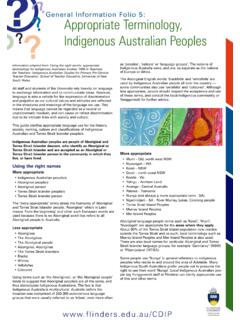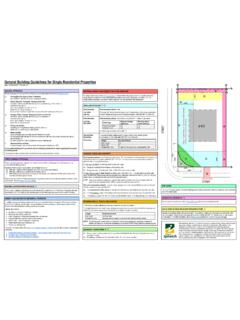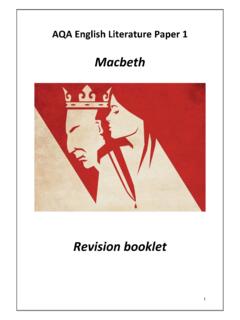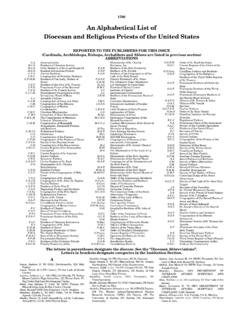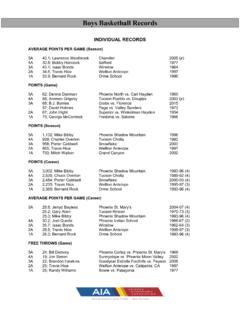Transcription of HISTORICAL TIME LINE - City of Ipswich
1 Ipswich History time line 1824-1829. 1824 A Convict Settlement was established at Moreton Bay, initially at Redcliffe and then at Brisbane Town. Lt John Oxley and Allan Cunningham discovered and named the Bremer River in 1824 (calling it Bremer's Creek), while they were exploring the Brisbane River. 1827 The Commandant of the Moreton Bay penal settlement, Captain Patrick Logan, established the lime- burning operation at Limestone Hills. An overseer and five convicts were stationed at Limestone Hills to quarry the Limestone. 1828 Allan Cunningham discovered a pass through the Great Dividing Range to the Darling Downs. This gap is now known as Cunningham's Gap. Sheep were sent to Limestone Station. Later a farm at the Plough Station (Raceview) was established. 1829 The first brick cottage erected at Limestone' on a block of land on the east side of what is now Thorn Street, next to the railway line c1829.
2 Allan Cunningham returned to Limestone Station and set out on a trip that went through Kholo, Pine Mountain, Grandchester, Lockyer Creek and the Laidley area. 1830-1839. 1830 Captain Patrick Logan was killed on an exploration journey to the Brisbane Valley. 1839 The penal settlement at Moreton Bay was officially closed down. George Thorn and his wife Jane arrived at Limestone Station. Thorn was appointed superintendent of the government pastoral station. 1840-1849. 1840 Squatters from the Darling Downs crossed the Dividing Range and visited Limestone. Free settlers were not allowed within 50 miles of the convict settlement unless special permission was obtained to allow them to proceed to Brisbane. After this time , Limestone became a regular stopping place between the Darling Downs and Brisbane. 1841 Great Flood in Ipswich and Brisbane. 1842 The Moreton Region was opened up for free settlement.
3 Henry Wade surveyed garden allotments at Little Ipswich (West Ipswich ), and then the township of Limestone'. 1843 In February 1843 Governor Gipps changed the name of the township from Limestone to Ipswich . On 11 October 1843 the auction of the first Ipswich allotments was held in Sydney. Coal found by Andrew Petrie at Redbank. 1844 Reverend Dr John Dunmore Lang held the first Presbyterian Church service in Ipswich . Jan 10 Heavy flood in Ipswich . 29 June First steamer, the Experiment' ran between Brisbane and Ipswich . 1845 George Thorn purchased Rosebrook' run (Normanby). 1846 The paddle steamer Experiment' owned by Mr James Canning Pearce, and under the command of Captain Alymer Campbell, became the first steamer to travel from Brisbane to Ipswich . Dr Dorsey was appointed the first magistrate of Ipswich and Henry McCrohan was appointed the first inspector of slaughterhouses and of cattle.
4 1847 Robert King & John Campbell established boiling-down works in Long Pocket. The first courthouse and lockup were erected in the police paddock. 1848 The first subdivision of crown land into small coal allotments was implemented at Woodend Pocket. The convict era in Ipswich ended when stock at the Plough Station were sold. The first St Mary's church was erected. 1849 Father James Hanly became the first resident priest in Ipswich . Benjamin Cribb established London Stores in Bell Street, forerunner of the firm of Cribb and Foote. Henry and Maria Mort settled at Franklyn Vale (they were the first white settlers in the Grandchester district). An Aboriginal Reserve was set up on the Bremer River (it was abandoned after 2 years). 1850-1859. 1850 Colin Peacock constructed the first racecourse in Ipswich , the Old Grange Racecourse. The School of Arts was established. Alexander McLeod formed the Loyal Ipswich Lodge of the Grand United Order of Oddfellows.
5 An Anglican Church was erected, which also served as a School. 1852 The North Australian Jockey Club was formed. Bathing Houses were erected at Ipswich by Owen Connor. 1853 The Bank of New South Wales opened on the corner of East Street and Union Street. The Bank of Australasia opened in Ipswich in the same year. Colonel Gray was appointed the first Police Magistrate in Ipswich . Reverend Dr William Lambie Nelson was appointed the first Presbyterian Church Minister in Ipswich . 1855 The partnership of Cribb and Foote was formed. The first newspaper in Ipswich , The North Australian, was established. The first Congregational Church in Ipswich opened on 11 March 1855. 1856 Site for Goodna Village determined. 1857 Claremont was completed as the residence of merchant John Panton and his wife Isabella. On 1 October the North Australian Club was founded in Ipswich . Flooding at Ipswich and at Brisbane.
6 1858 The second Wesleyan (Methodist) Church was built in Ellenborough Street, replacing a slab chapel. This brick church still stands and is now an Uniting Church. 25 October Foundation stone for the Roman catholic Church was laid. 10 December Meeting at Ipswich to petition for creation of municipality. 1859 The construction of the Ipswich courthouse was completed. The Ipswich Hospital at Denmark Hill was completed. St Paul's Anglican Church was opened on 12 June 1859. The Ipswich Herald (newspaper) was established (later became the Queensland Times). The proclamation separating the Colony of Queensland from New South Wales was read on 10 December 1859. 1860-1869. 1860 Coach service between Brisbane and Ipswich , returning same day, started 12 th February. Ipswich was proclaimed a Municipality on 2 March 1860. This was published in the Queensland Government Gazette on 3 March 1860. The first Mayor of Ipswich , John Murphy, was elected.
7 30 may First championship race Queensland at Ipswich . Cullen was appointed the first town clerk. Ipswich was gazetted as a customs port. An engineer was employed to survey and prepare plans for the formation of Brisbane Street. The first bridge over the Bremer River was erected. It was a floating bridge suspended between two punts. Queensland's first Defence Force was established in Ipswich . These first army Corps were the Ipswich Troop of the Queensland Mounted Rifles, and the First, or Ipswich , Company of the Queensland Rifle Brigade. The first Baptist Church was opened on the corner of Brisbane Street and West Street. St Mary's catholic Church was completed and the first mass was said on 3 November (this was the second church build on the site). 1861 The telegraph office in Ipswich was first opened on 13 April 1861. The telegraph line between Ipswich and Brisbane was completed. The first mining strike in Queensland occurred at Campbell & Towns coal mine at Redbank.
8 The Ipswich Herald was renamed The Queensland Times. 1862 The first Ipswich Post Office building was completed. The government appointed the trustees of Queens Park. 1863 16 February Serious flood in Brisbane and Ipswich . On 25 September 1863 the Governor of Queensland, Sir George Ferguson Bowen officially opened the Ipswich Grammar School. This was the first secondary school in Queensland. There was serious flooding in Ipswich . Robert Dunn purchased a block of land from the old Mt. Flinders sheep station (now the site of the township of Harrisville). An immigration depot was established at North Ipswich . 1864 Lady Bowen turned the first sod to start construction of the first railway in Queensland on 25 February 1864. The first railway workshops were established at North Ipswich . On 25 July 1864 the foundation stone for St Mary's Convent was laid by the Rev. James O'Quinn, Bishop of Brisbane (this was the first convent which has since been demolished).
9 1865 The first railway between Ipswich and Bigges Camp (Grandchester) was officially opened on 31 July 1865. The first iron rail and road bridge was constructed across the Bremer River, connecting North Ipswich and South Ipswich . The Ipswich Fire Brigade was established. George Cuthbert was appointed its first superintendent. Lewis Jones purchased land at Redbank Plains. 1866 St Stephens Presbyterian Church was erected (this was the second church on the same site). The first coal mine in Tivoli was opened by Hooper and Robinson. Samples of gold were found at Pine Mountain and in the Warrill Creek. 1867 12 April - Arrival of first train in Toowoomba (from Ipswich ). 30 April line between Ipswich and Toowoomba formally opened. 1868 Visit to Ipswich of the Duke of Edinburgh (son of Queen Victoria). First school at Redbank Plains was opened (the first teacher was John Carroll). Thomas Lorimer Smith took up land in the Rosewood Scrub.
10 1869 The Ipswich City council acquired the School of Arts and the Town Hall. 1870-1879. 1870 Lewis Thomas opened the Dinmore coal mine. 1871 John Phillip Jost took up land that was once a portion of Franklyn Vale and named it Jost Vale (now known as Hidden Vale). On 4 September the Purga Creek No. 2 School opened, it was renamed Peak Mountain State School in 1879 and became the Peak Crossing State School in 1929. 1872 Hancock Bros establish a sawmill and timber business at North Ipswich . 1873 30 January First sod of the Brisbane- Ipswich railway turned. The first pastoral and agricultural show ( Ipswich Show) was held on 13 May 1873 at Churchill. 24 April Baptists of Brisbane and Ipswich adopted resolutions in favour of a purely national system of education. 16 June Great meeting of Catholics at Brisbane and Ipswich to protest against the National Education Bill. 1874 The National Bank of Australasia' established its Ipswich Branch.
